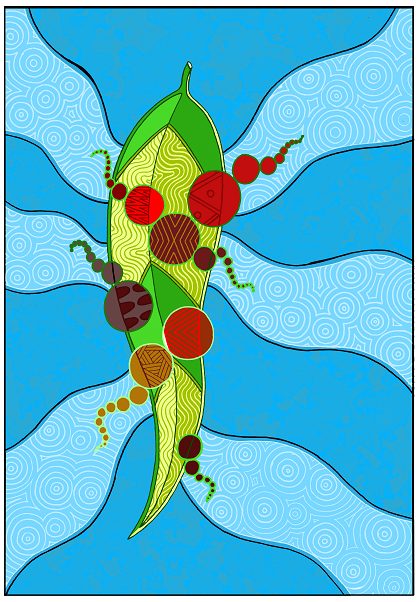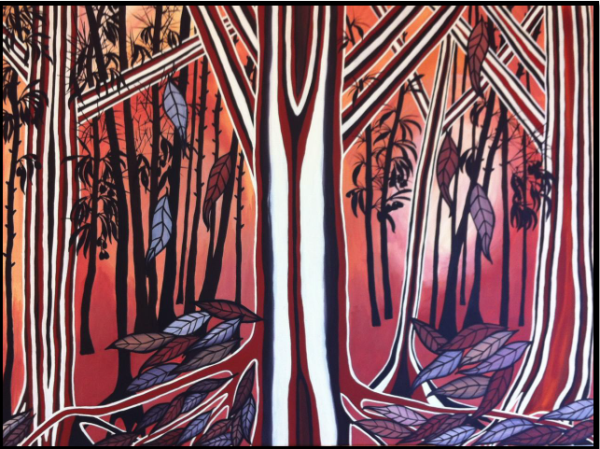The Royal Victorian Eye and Ear Hospital’s Aboriginal art collection showcases a diverse array of artworks by numerous Victorian artists. The works are displayed in various patient areas of the hospital and promote cultural awareness to all staff and visitors whilst fostering an environment of cultural safety for our Aboriginal and Torres Strait Islander patients. Each artwork reflects the artists unique style drawing on their connection to Country, community and culture.
Patients and Visitors › Aboriginal and Torres Strait Islander Health › Aboriginal art at the Eye and Ear
Aboriginal art at the Eye and Ear
-

GRAHAM GILBERT
Wiradjuri
On the Brink of ExctinctionLocation – Ground Floor Atrium, next to Cafe 1863
2023 – Acrylic on canvas
I like platypuses as they are a peaceful and calm animal.
Platypuses sense everything by feel and vibrations. They can’t see under the water. They show us how important it is to hear and sense the environment around us. When you see a platypus in the wild you feel how special they are.
Seeing them is a rare sighting that brings joy. They show us that you don’t need to have the ability of every sense to be strong and have normality.
Platypuses are solitary animals, but they will share waterways with other platypuses and lots of other animals.
Platypuses are more endangered today from the growing city, but you can still find them living in waterways throughout Melbourne and Victoria. Despite all the challenges and struggles they face; they are able to overcome them. We have to fight together to keep them alive and healthy. Just as the platypus continues to live under the changing environment, we work together to reconcile our past and create a stronger and safer future for all.
-

MANDY NICHOLSON
Wurundjeri-willam (Wurundjeri-baluk patriline)
Boon-marrit-tak gooreen Biik, Boon-marrit-tak gooreen gulinj
[Healthy Country, Healthy People]Location – Ground Floor Atrium, next to Cafe 1863
2015 – Acrylic on canvas
This artwork emphasises our connection to Country and how Country makes us strong. If our Country is not healthy, then we as people are not healthy. We have to look after it as our mother, we belong to it, not the other way around.
Mannagum leaf: This symbolises the welcoming of visitors from the Wurundjeri, the Traditional Custodians of Melbourne. Wurundjeri’s name derives from the mannagum and the leaves are used in Smoking/Welcoming Ceremonies. Embedded in the leaf are circles depicting continuation of cultural practises and ceremonies where we share our culture with others (the smaller connected circles). Our culture of yesterday is embedded in our culture today and will continue into the future.
Waterways: This symbolises all the waterways that run into the Birrarung (Yarra) and become one, so we begin our shared history of Melbourne.
-

Project proudly supported by WCMICSCONTRIBUTORS:
Eye and Ear staff, patients, volunteers and consumers
Western and Central Melbourne Cancer Services (WCMICS)
Victorian Aboriginal Health Service (VAHS)
Victorian Aboriginal Community Controlled Health Organisation (VACCHO)
Bendigo and District Aboriginal Cooperative (BDAC)
Parkville Precinct“Coming together with Possum Skin” in Taungurung language
2025 – Ochre on possum skin
-

EILEEN HARRISON
Kurnai
Healing flowers and the spiritual guardians2015 – Acrylic on canvas
I painted these images of flowers as they have opened up a whole new world for me. The wildness in the middle reflects on my healings, the white flowers depicts my guardians who helped me along the way, they are like butterflies strong and powerful. They are imbued with significance and spiritual connection with the land.
-

LUKE AND SIENA TIERI
Yorta Yorta
“Healthy eyes and ears” in Yorta Yorta languageLocation – Level 2, Surgical Admissions and Recovery waiting area
2025 – Acrylic on canvas
Yorta Itjumatj miyul marmu represents the cultural, social and emotional support the Ear and Ear Hospital provides to the Aboriginal community to ensure Aboriginal patients receive culturally appropriate health care and support.
Central to the design are two yarning circles representing the Aboriginal community and the Eye and Ear Hospital, connected by an ear shaped journey line. The ear shape represents the Ear, Nose and Throat (ENT) services that community access and also signifies the listening, yarning and sharing of knowledge through ongoing staff education to advance cultural safety, awareness and reconciliation. People situated along the journey line reflect community engagement and conversations to improve access to specialist eye and ear services and Close the Gap.
Meeting places connected by a light blue pathway frame the central design and represent the Eye and Ear as a state-wide service, acknowledging the travelling pathways of Aboriginal patients to access specialised treatment. The lines and dots beaming from the central ear shape show how we connect beyond the hospital to provide a holistic patient centred care. Green eye shapes surround some meeting places to represent eye clinics and subtly reflect the Eye and Ear’s symbolic Mannagum leaf.
The surrounding patterns depict integral elements of Country; blue water, green landscape and purple storylines and songlines embedding connection to Country.
-

EILEEN HARRISON
Kurnai
Wungandu yaail manda kulluck bunjil [Listening to the Old Ones in the Trees]2015 – Acrylic on canvas
This painting depicts the relationship between the ancient and the new, and the importance of listening deeply to the wisdom of the Old Ones. The large trees in the front of the painting represent the Elders of the forest. The younger trees symbolise the growth of new generations. The Old Ones are looking after the young ones as they develop. The leaves hold knowledge and will fall from the trees and enrich the Earth. The young trees are drawing on the knowledge within the leaves. The young ones are listening to the Elders’ stories of strength, knowledge and wisdom. They are listening deeply from the heart of their being.
The Elders and the young ones are growing together. Both are being sustained by the Earth.
-

RAY THOMAS
Brabrawooloong Gunnai, Kirrae-wuurung, Djadjawali
That Time of the DayLocation – Ground Floor Pharmacy, next to Gisborne Street entrance
2015 – Acrylic on canvas
This painting is about that time of the day when we sit and reflect on ourselves and life. Boran the Pelican is the ancestral creator for the Gunnai of Gippsland, eastern Victoria. The lizards in the bottom half of the painting relate to the Bataluk Cultural trail in Gippsland. Bataluk is the Gunnai language word for lizard. If you go on this journey along the Bataluk Cultural Trail you will come across scenery like this. With our mri (eyes) and wrung (ears) we are able to take in the breath taking beauty of Gippsland, its lakes and bushland and listen to the sound of all the different totem animals that inhabit this beautiful part of the country.
-

VICKI COUZENS
Keerray Woorroong/Gunditjmara
Wangan ngakee ngootyoong (hear and see good)Location – Level 1 Specialist Clinics, Blue Wing
2015 – Acrylic on canvas
‘‘Dadirri’’ is an Aboriginal concept meaning deep and respectful listening, which builds community (Atkinson 2001, 2002; Ungunmerr 1989). This concept comes from the language of the Ngangikurungkurr people of the Daly River area of the Northern Territory. ‘Ngangi’ means word or sound. ‘Kuri’ means water and ‘kurr’ means deep. Deep water sound or sounds of the deep, also explain the word ‘‘Dadirri’’ as inner deep listening and quiet still awareness. In my language we say ‘wangan ngootyoong’.
‘wangan ngakee ngootyoong’ translates literally as hear/listen and see good. This work literally represents good or healthy hearing and seeing. The design is inspired from cellular parts of receptors and neural synapses in the retina which transmit visual signals to the brain. The spiral references the cochlear which is part of the physiology of the ear, capturing aural messages.In the context of ‘dadirri’/wangan ngootyoong, this work also brings deeper meaning. The concept of health from an Aboriginal worldview includes physical, mental, emotional and spiritual wellbeing; balance, place and belonging.
The designs in this work are inspired through research into DNA and cells. How our bodies are built and work in receiving information and messages. DNA holds the matrix of who we are and where we belong. There is knowledge held in our DNA: ‘our blood, bones and stories are in this Country’.
The receptors, neural synapses and cochlear are visual interpretations of ‘deep listening’, visual, aural, emothional (heart) and spirit levels.
These images evoke the sense of ‘deep listening’ – listening with your spirit, your heart as interconnected beings in the cycle of life, part of nature, related to all, children of Mother Earth.The spiral, again the universal symbol for life birth death and the continuing cycles that turn from the life of a butterfly who lives two weeks to the neverending cycles of the cosmos. Culture is the framework through which we are connected to our world and the spiral is a representation of the elements of culture – language, song, story, dance, knowledge.
-

LUKE AND SIENA TIERI
Yorta Yorta
Wanangbagan Daborra – (Healthy Pathways)Location – Ground Floor, Emergency Department waiting room
2024 – Acrylic on canvas
Wanangbagan Daborra meaning “healthy pathways” in Yorta Yorta language represents the connection and collaboration between Aboriginal and Torres Strait Islander people, health care providers and the community. The artwork features four large yarning circles representing yarning and patient engagement to develop meaningful relationships. Green U shapes inside the central yarning circle depict people sitting and symbolise the Eye and Ear’s central ethos; ongoing commitment to patient-focussed, quality health care. Each yarning circle also represents a value of health; emotional, mental, physical and spiritual contributing to a holistic approach to positive health and wellbeing.
The yarning circles are linked by green journey lines representing patient pathways creating a system of social connection, access, support and engagement. Connection and care for Country is integral to cultural health and wellbeing. Native plants represent the healing qualities from cultivating traditional bush tucker and botanicals, and green and blue dots depict the importance of land and water; land nourishes us to ensure community survival and water embodies healing and cleansing properties.
Yellow rays acknowledge the Sun as The Giver of Life providing light and warmth contributing to each patient’s healthy pathway and positive wellbeing.








